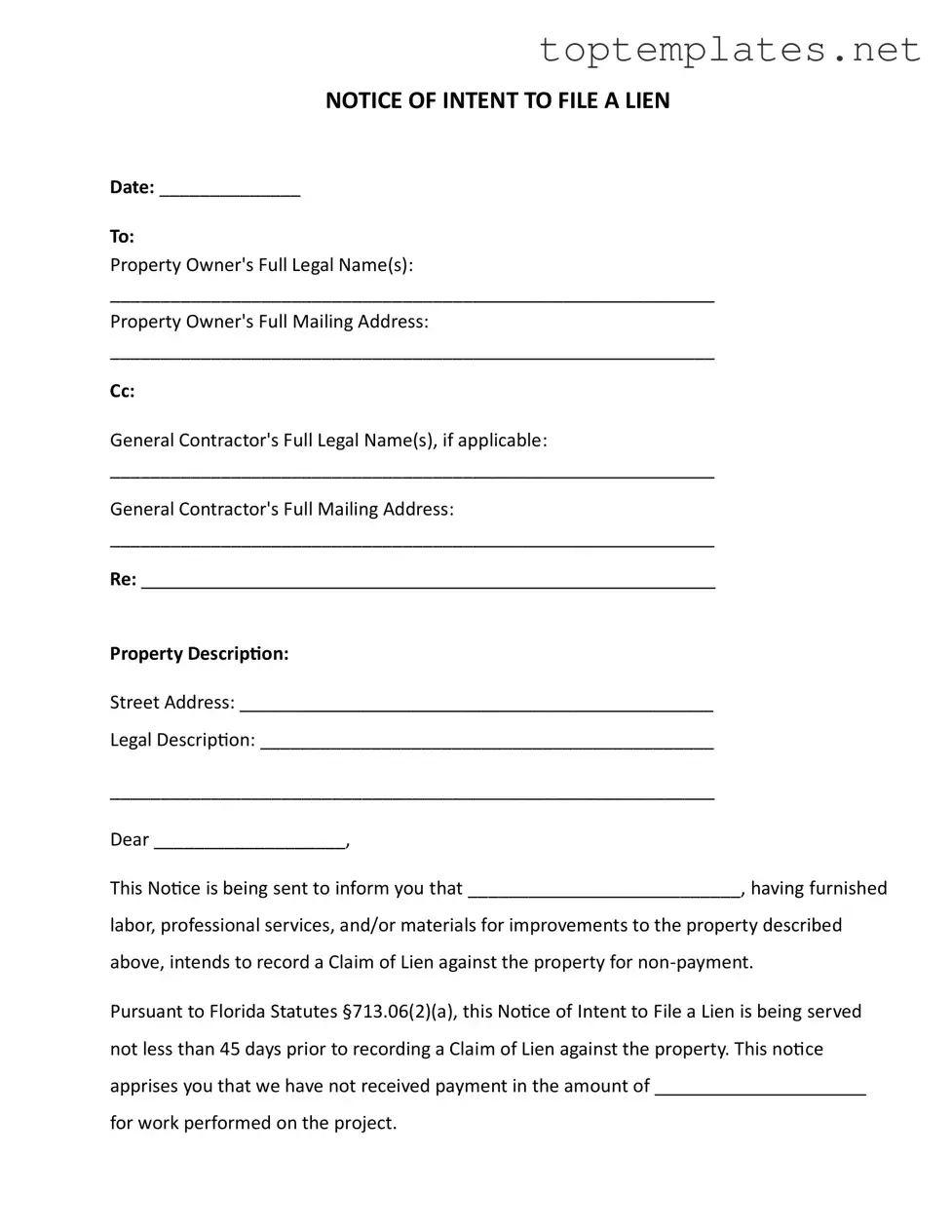What is a Notice of Intent to File a Lien in Florida?
A Notice of Intent to File a Lien is a legal document that must be served to a property owner in Florida, informing them that a lien will be placed against their property due to unpaid labor, services, or materials. This notice is a mandatory step before recording a Claim of Lien, and it serves as a final warning to the property owner to settle the outstanding payment or face a lien against their property.
When must the Notice of Intent to File a Lien be served?
Under Florida Statutes §713.06(2)(a), the Notice of Intent to File a Lien must be served to the property owner at least 45 days before recording the Claim of Lien.
What should be included in the Notice of Intent to File a Lien?
The notice must include the date, full legal names and addresses of the property owner and, if applicable, the general contractor. It also must describe the property, the nature of the work performed or materials provided, the amount unpaid, and the intention to file a lien if payment is not made. Additionally, a Certificate of Service showing how the notice was delivered must be included.
How can the Notice of Intent to File a Lien be delivered?
The notice can be delivered by certified mail, registered mail, hand delivery, delivery by a process server, or publication, as required by law, to ensure that the property owner receives it. Whichever method is chosen, it must be documented in the Certificate of Service.
What happens if the recipient does not respond to the Notice of Intent to File a Lien?
If the property owner does not respond with payment or a satisfactory resolution within 30 days as outlined by Florida Statutes §713.06(2)(b), the party that served the notice may proceed to file a lien against the property.
Can a Notice of Intent to File a Lien lead to foreclosure?
Yes, once a lien is placed on a property, if it remains unpaid, it could potentially lead to foreclosure proceedings. This is because a lien is a legal claim against the property for unpaid debt, allowing the lienholder to pursue foreclosure to recover the owed amounts.
Are there any costs associated with filing a Notice of Intent to File a Lien?
While there are minimal costs associated with serving the Notice of Intent, such as postage for certified mail, the subsequent step of recording a lien requires payment of a fee to the County Recorder's Office. Additional costs may accrue if legal assistance is sought to prepare the document.
Can a Notice of Intent to File a Lien be disputed?
Yes, a property owner may dispute a Notice of Intent to File a Lien if they believe it to be unjustified. This could be due to a disagreement over the amount owed, the quality of work done, or other reasons. Disputes are typically resolved through negotiation, mediation, or, if necessary, legal action.
What should a property owner do upon receiving a Notice of Intent to File a Lien?
Upon receiving the notice, a property owner should immediately contact the sender to discuss the matter. It is advisable to attempt to resolve the issue promptly, either by verifying and paying the outstanding amount or by negotiating a satisfactory compromise for both parties.
Does providing a Notice of Intent to File a Lien affect the validity of the eventual lien?
Serving a Notice of Intent to File a Lien does not in itself affect the validity of a lien. However, failing to serve this notice according to the statutory requirements can render a subsequently filed lien invalid. This step must be completed correctly to maintain the right to enforce the lien.

